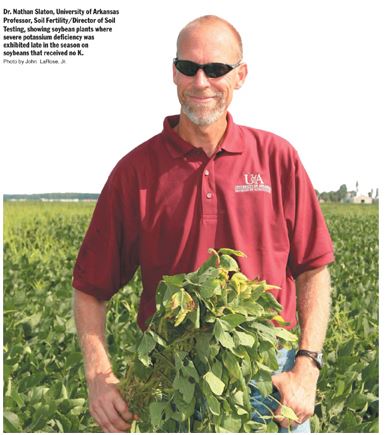Soybean K Rates
Trial Aims To Save Farmers Money On Potassium Applications
STUTTGART, ARK.
Potassium nutrition for soybean was discussed recently by Dr. Nathan Slaton, University of Arkansas Professor, Soil Fertility/Director of Soil Testing.
“We have a test at the Pine Tree Station where we have applied the same rates of potassium for 10 years and cropped it to a rice-soybean rotation,” Slaton said. “For the first couple of rice crops, there was very little to no yield response to potassium fertilization, but there was a significant yield increase to potassium the first year soybean was grown.”
Last year was the ninth year of the study and there was an 80 bushel difference between the rice that received no potassium and the highest yielding treatment that received potassium.
Slaton showed soybean plants taken from those same plots where severe potassium deficiency was exhibited late in the season on soybeans that received no K; very subtle potassium deficiency symptoms on soybean that received 40 units of potash per acre per year; and very good looking dark green plants with lots of pods where they have received sufficient potassium.

“The potassium deficiency symptoms late in the season quite often appear on the upper leaves of the plant,” Slaton explained.
“Generally we consider potassium to be mobile in the plant, and we would expect potassium deficiency symptoms to occur on the lower leaves first as the potassium in those lower leaves is moved to the active growing point or the seed. But in this case the soybean seed is a sink and the potassium is being moved not only from the lower leaves but also the upper and middle leaves of the plant and that basically gives the yellowing Christmas tree type appearance on the upper leaves.”
From the research that’s been conducted with potassium on soybean, Slaton recommends (for Arkansas) that samples be taken from the top four inches of soil. Research has shown that soil test K is a very good indicator K availability.
“To put that in laymans terms, the soil test does a very good job of predicting K deficient fields and the K fertilizer rates that we recommend are actually pretty accurate,” he said. “Generally when you’re very low in potassium which we would describe as less than 61 parts per million, we would recommend 160 units of potash, which is a lot. You can probably maximize yield with about 120 units at that very low soil test. The reason we recommend a little bit more is to try to build that soil test up a little bit over time. 120 units would be recommended for 61 to 90 parts per million, and 60 units would be recommended for 91 to 130 parts per million; then we would recommend another 50 units when soil test K is 131 to 170 just to try to replace a little bit of what the crop is removing.”
One reason for the concern is that potassium fertilizer has been extremely expensive due to a short fall in world production. Potassium had been running $800 a ton (in 2009), which is pretty expensive when you start talking about rates that are approaching or even exceeding 100 units of potash per acre.
Many farmers question whether they really need potash or whether they can adjust the rate just to get by. In some cases, farmers have had to cut it out to try to reduce their expenses.
“So the take home message here is that if you have been reducing potassium inputs you need to take a real hard look at that because on the silt loam soils in Arkansas the buffering capacity is low, meaning that these soils can change quite rapidly; and within a period of two to three years of potassium cut back, you can see pretty significant changes in K availability and crop yields,” Slaton said.
Soil tests can help the farmer know where he stands.
“I would probably recommend a soil test every four to five years on clay soils unless there are production problems that are believed to be linked to fertility,” he recommended. “On silt and sandy loam soils, definitely test once every three years, especially if your fertility levels are medium to optimum; but if your fertility levels are medium or lower then I would recommend once every two years or perhaps even annually. The main thing is that farmers, when they sample, try to sample at the same time of year; and make sure they keep a uniform sample depth; and when they’re sampling in a rotation to try and sample after that same crop, such as always sample after your soybeans.”
Methods of sampling vary depending on the farmer.
“As a general rule of thumb we have two groups of folks here in Arkansas,” he continued. “There are grid sample people who are doing one sample every 2.5 acres, and that’s wonderful; we have another group that takes one or two samples per field so that the field average method a lot of times results in one sample representing 45 acres.
Trying to come up with a set rule is very difficult because of the variability among fields so I would suggest that farmers sample on zones. Within fields, especially those that are irrigated, they need to take into account the way that irrigation water moves across the field because you can have pH and fertility gradients there. They need to consider soil changes, the different topography, the hillsides, valleys. So it’s a tough to give a farmer just one answer, but certainly try to isolate zones either from yield appearance, or soil properties, and do your samples that way.” Δ
BETTY VALLE GEGG-NAEGER: Senior Staff Writer, MidAmerica Farmer Grower
Dr. Nathan Slaton, University of Arkansas Professor, Soil Fertility/Director of Soil Testing, showing soybean plants where severe potassium deficiency was exhibited late in the season on soybeans that received no K. Photo by John LaRose, Jr.